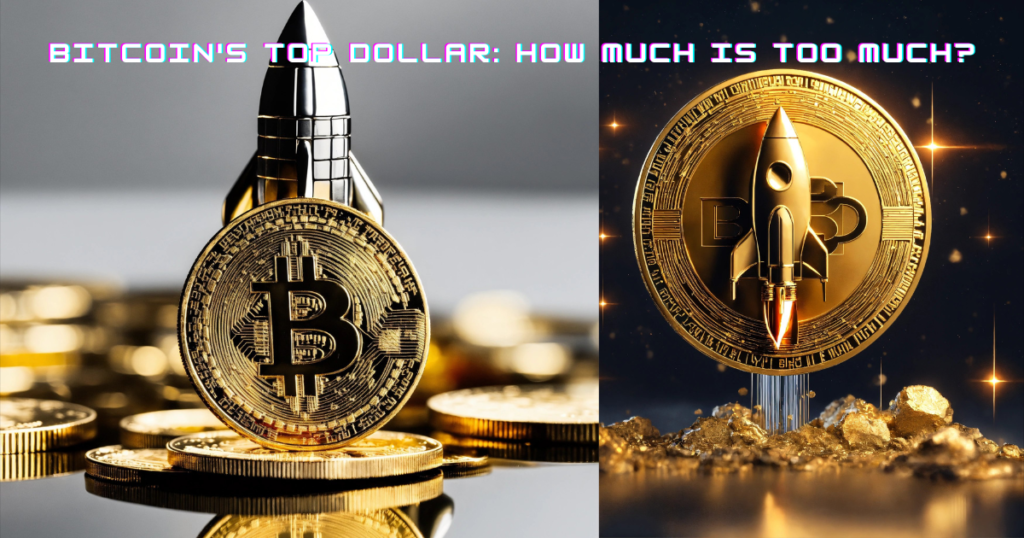Introduction
Bitcoin, the enigmatic digital currency that has captured the imagination of millions, has experienced wild price swings over the years. From its humble beginnings to its jaw-dropping all-time high, Bitcoin’s Top Dollar journey is nothing short of remarkable. But what factors have propelled it to such astronomical heights? Let’s unravel the secrets.

Unveiling the Secrets of Bitcoin’s Top Dollar
1. The All-Time High (ATH): Bitcoin’s Top Dollar
Before we delve into the intricacies, let’s set the stage. On November 8, 2021, Bitcoin achieved its all-time high, reaching an astonishing price of $67,567 per coin . This historic moment marked the culmination of years of growth, speculation, and fervent debates.
2. Institutional Demand
The first secret lies in the growing appetite of global institutions for Bitcoin. Unlike previous bull markets, where retail investors dominated, this time institutional players are leading the charge. Hedge funds, asset managers, and even publicly traded companies are allocating portions of their portfolios to Bitcoin. Why? Because they recognize its potential as a store of value and a hedge against inflation .
Institutional demand brings stability and credibility to the market. When large institutions invest, it signals confidence in Bitcoin’s long-term viability.
3. Spot Bitcoin ETFs: A Game Changer
Enter the spotlight: spot Bitcoin exchange-traded funds (ETFs). These financial instruments allow investors to gain exposure to Bitcoin without directly owning the cryptocurrency. In February, U.S. spot Bitcoin ETFs witnessed record daily trading volumes, contributing significantly to the price surge.
How does it work? Imagine a basket of bananas (yes, we’ll stick to our banana analogy). As more people want to own bananas (Bitcoin), the demand increases. But there’s a twist: there’s a limited supply of bananas available. This scarcity drives up the price. Similarly, spot Bitcoin ETFs create a demand for Bitcoin without affecting the actual supply, resulting in upward pressure on prices .
4. Psychological Milestones-Bitcoin’s Top Dollar
Bitcoin’s ascent wasn’t a smooth ride. Breaking the $50,000 barrier earlier this year was a psychological milestone. It signaled to the world that Bitcoin was no longer a fringe asset—it had entered the mainstream. But it didn’t stop there. The cryptocurrency soared past $60,000, igniting market euphoria. Experts like Tom Lee of Fundstrat Global Advisors even projected a mind-boggling price target of $500,000 within the next five years .
These milestones matter. They create buzz, attract attention, and fuel investor optimism. When Bitcoin surpasses a round-number threshold, it becomes a self-fulfilling prophecy—a beacon for more investors to join the party.
5. The Impending Bitcoin Halving
Picture this: every four years, Bitcoin undergoes a significant event known as halving. During halving, the rate at which new Bitcoins mined is cut in half. The result? Bitcoin becomes scarcer. Scarcity, my friends, is a powerful force. As institutional adoption grows, the reduced supply could catapult Bitcoin to new and unprecedented price levels .
Conclusion: Bitcoin’s Top Dollar
Bitcoin’s highest price isn’t a fluke; it’s the outcome of a perfect storm: institutional interest, spot Bitcoin ETFs, psychological milestones, and the impending halving. As we gaze into the future, keep an eye on these factors—they might just be the secret ingredients that propel Bitcoin to even greater heights.
Remember, investing in cryptocurrencies carries risks, and prices can be as volatile as a banana peel on a rainy day. But understanding the forces shaping Bitcoin’s price can help you navigate this thrilling and ever-evolving landscape.

How does mining affect Bitcoin’s price? Bitcoin’s Top Dollar
Bitcoin mining plays a crucial role in shaping its price. Let’s delve into the fascinating interplay between mining and Bitcoin’s value:
1. Supply and Demand Dynamics:
- Bitcoin’s supply is limited—there will only ever be 21 million coins produced, and they are projected to be mined by 2140.
- The protocol ensures that new bitcoins are rewarded at a fixed rate, which slows down over time. This reduction in rewards occurs approximately every four years during a process called halving.
- The last halving event was in 2020, and the next one is expected in April.
- As the supply dwindles, demand increases, mimicking the scarcity of gold. Investors anticipate this scarcity, leading to potential price growth.
2. Mining Costs and Scarcity:
- Mining new bitcoins becomes more expensive over time due to halving.
- Imagine if corn harvests reduced every four years until no more corn could be harvested—the scarcity would drive corn prices higher.
- Similarly, Bitcoin’s future supply reduction adds to its allure and demand.
3. Media and Sentiment:
- Media coverage, investor sentiment, and expert opinions influence Bitcoin’s price.
- The recent approval of spot Bitcoin ETFs has further fueled demand.
- Institutions may need to buy more Bitcoin on the open market to back the flows into their funds.
4. Environmental Impact:
- The difficulty level of Bitcoin’s algorithm affects mining costs.
- Negative sentiment due to environmental concerns can lead to sell-offs and price dips.
5. Historical Trends:
- Bitcoin’s value has historically increased after each halving event, although with diminishing returns.
- While the upcoming halving is widely known, its implications may still impact the current price.
In summary, Bitcoin mining affects its price through scarcity, costs, investor sentiment, and historical patterns. Remember that Bitcoin is highly speculative and volatile, so consider it as part of a diversified investment portfolio.
FAQs: People also ask
1.What was the highest price for Bitcoin?
The highest price for Bitcoin was recorded on November 8, 2021, reaching an astonishing $67,567 per coin.
2.What is the highest price Bitcoin could go?
Predicting the absolute highest price Bitcoin could reach is challenging due to the cryptocurrency’s volatile nature. However, market analysts and experts often provide speculative projections based on various factors such as institutional adoption, market trends, and macroeconomic conditions.
3.What is Bitcoin’s max price?
Bitcoin’s maximum price is subject to market forces, investor sentiment, and global economic factors. As of now, historical data indicates that the highest recorded price is $67,567, but future developments in the cryptocurrency market could influence new record highs.
Disclaimer
This article relies on internal data, publicly available information, and other reliable sources. It may also include the authors’ personal views. However, it’s essential to note that the information is for general, educational, and awareness purposes only—it doesn’t disclose every material fact.
We publish information on World Virtual CFO in good faith, solely for general information. World Virtual CFO doesn’t guarantee the completeness, reliability, or accuracy of this information. These are our views for informational purposes. When you use our website, know that any action you take is entirely at your own risk. World Virtual CFO won’t be liable for any losses or damages connected to your use of our website. For detailed information, refer to our disclaimer page.
Dr. Dinesh Sharma is an award-winning CFO and AI strategist with over two decades of experience in financial leadership, digital transformation, and business optimization. As the founder of multiple niche platforms—including WorldVirtualCFO.com—he empowers professionals and organizations with strategic insights, system structuring, and innovative tools for sustainable growth. His blogs and e-books blend precision with vision, making complex financial and technological concepts accessible and actionable.
1 thought on “Bitcoin’s Top Dollar: How Much is Too Much? Know now”